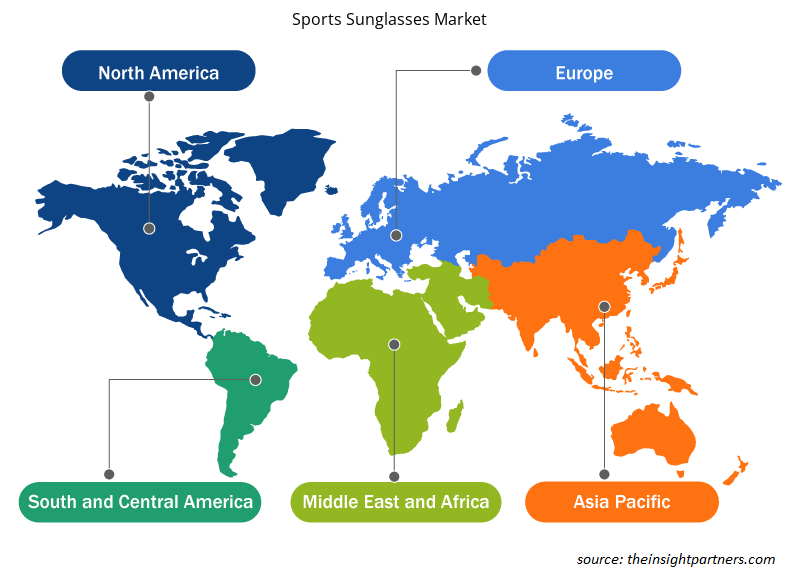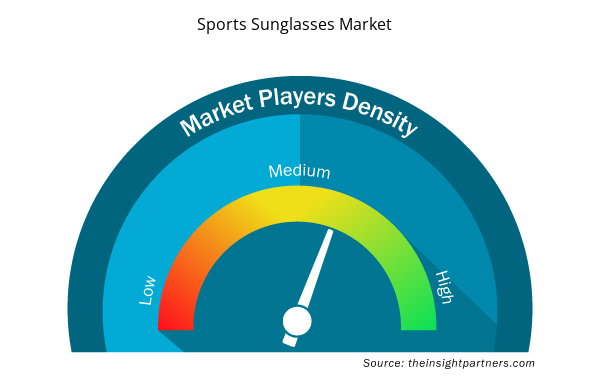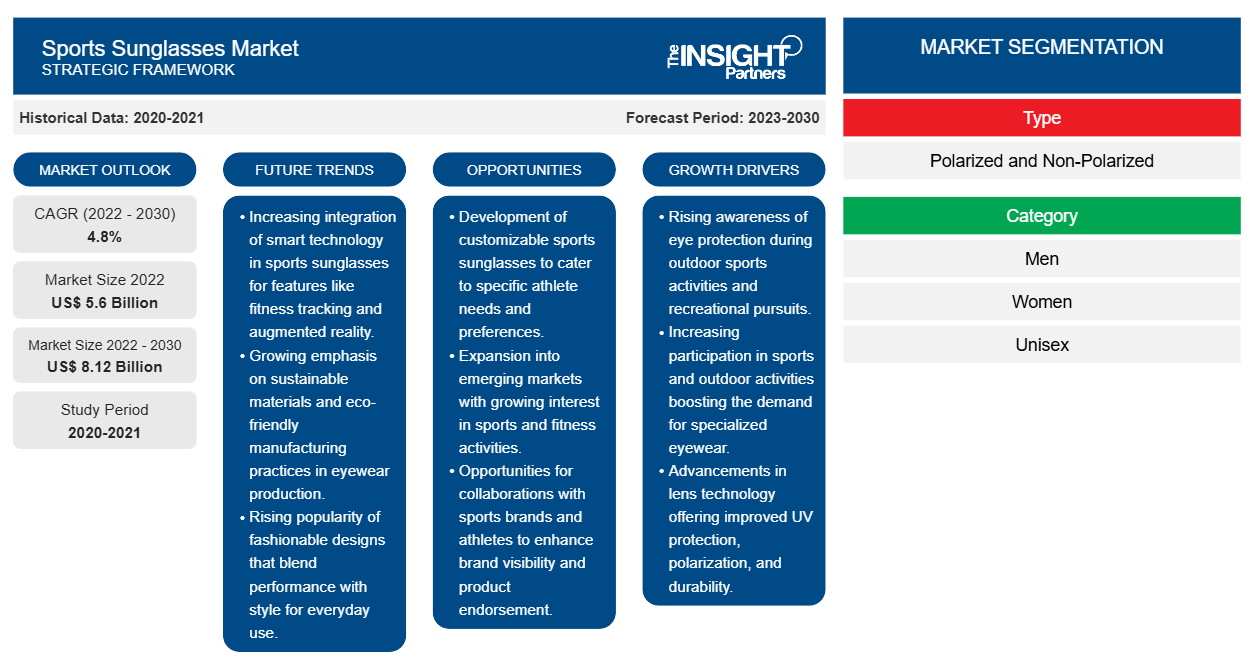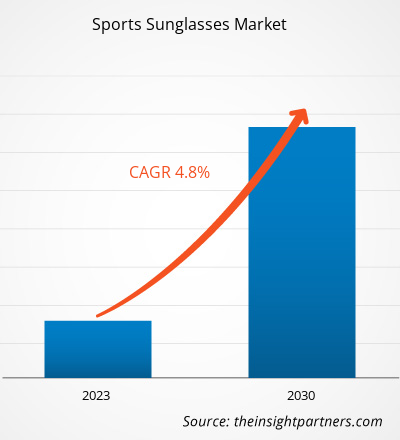[研究报告] 运动太阳镜市场规模预计将从 2022 年的 55.9708 亿美元增长到 2030 年的 81.1506 亿美元;预计 2022 年至 2030 年市场复合年增长率为 4.8%。
市场洞察和分析师观点:
运动太阳镜是一种防护眼镜,用于在户外运动时提高能见度和舒适度。它们最大限度地减少强烈阳光的照射,以防止对眼睛造成任何伤害。镜片采用塑料或玻璃材料制成。它们涂有紫外线 (UV) 阻隔剂和抗冲击膜,可减少眩光并提高对比度,从而提高现场能见度。太阳镜也有偏光或非偏光类型,配有有色和非有色镜片,适合日常佩戴。运动太阳镜通常在进行体育活动时使用,例如骑自行车、游泳、山地自行车、骑自行车、棒球、板球和其他户外活动。这些因素推动了运动太阳镜市场的发展
增长动力和挑战:
许多人从事各种运动和户外活动。运动爱好者了解保护眼睛免受灰尘、风和碎屑等潜在风险的影响的重要性。因此,他们使用运动太阳镜,旨在提供最佳保护并提高运动期间的表现。根据体育和健身行业协会 (SFIA) 的数据,2022 年美国超过 76% 的人口(即 2.369 亿人)参加了至少一项活动,总参与率比 2017 年增长了 9.2%,比 2021 年增长了 1.9%。此外,根据欧盟统计局的数据,2019 年,约 44% 的欧洲人口每周至少进行一次体育活动。此外,各种各样的运动和户外活动也产生了对满足特定需求的运动太阳镜的需求。
此外,文化转向更健康、更积极的生活方式,参与体育运动和户外活动的人数也随之增加。这种转变不仅限于竞技运动员,还包括参与休闲运动、跑步、徒步旅行和其他休闲活动的个人。运动太阳镜已成为一种时尚宣言和这种积极生活方式的象征。
长时间暴露于紫外线 (UV) 辐射,尤其是在户外环境中,会导致各种眼部疾病,如白内障、光性角膜炎和翼状胬肉。这些疾病会导致不适、视力受损,在某些情况下甚至会导致永久性眼部损伤。从事体育或其他户外活动时,人们需要清晰无损的视力才能发挥最佳水平。过度暴露于紫外线会导致眯眼、不适和视力下降。具有防紫外线功能的运动太阳镜可确保运动员在活动期间保持最佳视力和注意力,从而提高他们的整体表现。
定制此报告以满足您的需求
您可以免费定制任何报告,包括本报告的部分内容、国家级分析、Excel 数据包,以及为初创企业和大学提供优惠和折扣
- 获取此报告的关键市场趋势。这个免费样品将包括数据分析,从市场趋势到估计和预测。
报告细分和范围:
“全球运动太阳镜市场”根据类型、类别、分销渠道和地理位置进行细分。根据类型,运动太阳镜市场分为偏光和非偏光。在类别方面,市场分为男士、女士、中性和儿童。根据分销渠道,运动太阳镜市场分为超市和大卖场、专卖店、在线零售和其他。按地理位置,市场分为北美(美国、加拿大和墨西哥)、欧洲(德国、法国、意大利、英国、俄罗斯和欧洲其他地区)、亚太地区(澳大利亚、中国、日本、印度、韩国和亚太地区其他地区)、中东和非洲(南非、沙特阿拉伯、阿联酋和中东和非洲其他地区)以及南美洲和中美洲(巴西、阿根廷和南美洲和中美洲其他地区)
节段分析:
根据类型,运动太阳镜市场分为偏光和非偏光。非偏光太阳镜在 2022 年占据了相当大的市场份额。运动员和健身爱好者对非偏光运动太阳镜的需求正在激增,他们需要在运动期间保护眼睛,同时确保整体健康。镜片技术的进步带来了更轻便、舒适和耐用的非偏光运动太阳镜的推出,吸引了更广泛的受众。此外,时尚行业对运动配饰的影响也增加了时尚实用的非偏光运动太阳镜在那些追求眼镜性能和美感的人们中的受欢迎程度。
区域分析:
根据地理位置,运动太阳镜市场分为五个主要区域——北美、欧洲、亚太地区、南美和中美以及中东和非洲。北美主导了全球运动太阳镜市场。2022 年,该区域市场价值为 17.91 亿美元。欧洲是该市场的第二大贡献者,占全球市场的近 25%。预计在预测期内,中东和非洲的运动太阳镜市场的复合年增长率将达到 6.5%。在北美,由于运动参与度的提高和对眼睛保护的意识的增强,市场预计将大幅增长。根据体育和健身行业协会 (SFIA) 的数据,2022 年,超过 76% 的美国人(即 2.369 亿人)参加了至少一项体育活动。因此,北美人对不同运动类别的参与度不断提高,进一步刺激了该地区对运动太阳镜的需求。此外,由于政府对体育领域的大量投资,中东和非洲市场也出现了显著增长。例如,包括沙特阿拉伯和阿联酋在内的海湾合作委员会 (GCC) 成员国在 2022 年花费了超过 650 亿美元用于体育发展,主要关注足球和电子竞技,这两个领域被认为具有最大的收入增长潜力。个人和健身爱好者对体育和身体健康重要性的认识不断提高,推动了中东和非洲对运动太阳镜的需求。
行业发展和未来机遇:
以下列出了运动太阳镜市场主要参与者采取的各种举措:
- 2022年12月,英国眼镜品牌SunGod与伦敦crit自行车队合作,推出Tekkerz Vulcanz Vulcanz太阳镜,该款太阳镜包含光致变色镜片、紫外线记忆聚合物镜框以及亲水性耳袜和鼻托。
运动太阳镜市场区域洞察
Insight Partners 的分析师已详细解释了预测期内影响运动太阳镜市场的区域趋势和因素。本节还讨论了北美、欧洲、亚太地区、中东和非洲以及南美和中美洲的运动太阳镜市场细分和地理位置。

- 获取运动太阳镜市场的区域特定数据
运动太阳镜市场报告范围
| 报告属性 | 细节 |
|---|---|
| 2022 年市场规模 | 56亿美元 |
| 2030 年的市场规模 | 81.2亿美元 |
| 全球复合年增长率(2022 - 2030 年) | 4.8% |
| 史料 | 2020-2021 |
| 预测期 | 2023-2030 |
| 涵盖的领域 | 按类型
|
| 覆盖地区和国家 | 北美
|
| 市场领导者和主要公司简介 |
|
运动太阳镜市场参与者密度:了解其对商业动态的影响
运动太阳镜市场正在快速增长,这得益于消费者偏好的不断变化、技术进步以及对产品优势的认识不断提高等因素导致的终端用户需求不断增加。随着需求的增加,企业正在扩大其产品范围,进行创新以满足消费者的需求,并利用新兴趋势,从而进一步推动市场增长。
市场参与者密度是指在特定市场或行业内运营的企业或公司的分布情况。它表明在给定市场空间中,相对于其规模或总市场价值,有多少竞争对手(市场参与者)存在。
在运动太阳镜市场运营的主要公司有:
- 迪卡侬
- 阿迪达斯公司
- 陆逊梯卡集团
- 自由运动
- 耐克公司
免责声明:上面列出的公司没有按照任何特定顺序排列。

- 了解运动太阳镜市场顶级关键参与者概况
COVID-19 疫情影响:
COVID-19 疫情对各国几乎所有行业都产生了不利影响。北美、欧洲、亚太地区 (APAC)、南美和中美以及中东和非洲 (MEA) 的封锁、旅行限制和企业关闭阻碍了多个行业的增长,包括消费品行业。制造部门的关闭扰乱了全球供应链、制造活动、交付计划以及必需品和非必需品销售。各公司报告称,2020 年产品交付延迟,产品销售下滑。此外,在危机初期,制造商主要依赖现有库存。由于疫情引发的经济衰退,消费者在购买决策方面变得更加谨慎和挑剔。由于收入较低和收入前景不确定,他们大大限制了非必需品的购买,尤其是在发展中地区。
到 2021 年底,许多国家都已全面接种疫苗,各国政府宣布放宽某些规定,包括封锁和旅行禁令。疫情后生活方式的变化,例如越来越重视舒适性、便利性和个性化,影响了对运动太阳镜的需求。疫情期间在线零售的增长也为运动太阳镜制造商提供了机会。除此之外,贸易限制的放宽也有助于进出口业务,对运动太阳镜市场的增长产生了积极影响。
竞争格局和重点公司:
Columbia Sportswear Co、EssilorLuxottica SA、Liberty Sport Inc、Under Armour Inc、Nike Inc、Rapha Racing Ltd、Puma SE、Decathlon SE、Adidas AG 和 Safilo Group SpA 是全球运动太阳镜市场的知名企业。这些市场参与者采取战略发展举措进行扩张,进一步推动市场增长。
- 历史分析(2 年)、基准年、预测(7 年)及复合年增长率
- PEST 和 SWOT 分析
- 市场规模价值/数量 - 全球、区域、国家
- 行业和竞争格局
- Excel 数据集



Report Coverage
Revenue forecast, Company Analysis, Industry landscape, Growth factors, and Trends

Segment Covered
This text is related
to segments covered.

Regional Scope
North America, Europe, Asia Pacific, Middle East & Africa, South & Central America

Country Scope
This text is related
to country scope.
常见问题
Based on distribution channel, the sports sunglasses market is segmented into supermarkets and hypermarkets, specialty stores, online retail, and others. Specialty stores are experiencing a surge in demand for sports sunglasses because of their expertise and focused product range. Customers explicitly looking for high-quality sports eyewear prefer these stores as they offer a curated selection, often from well-known brands. The staff in these stores are knowledgeable about the products, providing personalized recommendations based on the customer's needs. Moreover, specialty stores often host events or collaborations with athletes, creating a unique shopping experience enthusiasts appreciate. The emphasis on expertise and a tailored shopping experience make specialty stores a hot sport for sports sunglasses enthusiasts.
Sustainability and eco-friendly products have emerged as a significant trend in the sports sunglasses market, reflecting a growing awareness and commitment to environmental responsibility among consumers and manufacturers alike. This trend can be attributed to several key factors that highlight the importance of sustainability in the industry. Consumers are increasingly demanding products that align with their eco-conscious values. As environmental concerns become more pronounced, individuals participating in outdoor activities and sports seek products that minimize their ecological footprint. Sports sunglasses made from sustainable materials, such as recycled plastics, bamboo, or other biodegradable options, have gained popularity. These materials reduce the environmental impact of manufacturing and offer a more sustainable end-of-life cycle, which resonates with eco-conscious consumers.
The major players operating in the global sports sunglasses market are Decathlon, Adidas AG, Luxottica Group, Liberty Sport, Nike Inc, Puma SE, Safilo Group Spa, Under Armour Inc, Columbia Sportswear Company, and Rapha Racing LimitedInc among others.
In 2022, North America region accounted for the largest share of the global sports sunglasses market. The North America sports sunglasses market is segmented into the US, Canada, and Mexico. The regional market is influenced by diverse consumer preferences, including choices between polarized and non-polarized sports sunglasses, and a range of availability of specific designs for all the genders such as men, women, unisex, and kids. In north America, the sports sunglasses sales are driven by different retail channels including supermarkets, specialty stores, online retail platforms, eyecare clinics, and fashion boutiques, catering to a wide range of customers. Also, participation in sports events and exposure through fitness centers play a significant role, as sports enthusiasts seek specialized eyewear for their activities, boosting the demand for sports sunglasses across the region. According to the Sports & Fitness Industry Association (SFIA), more than 76% of all Americans, or 236.9 million people, participated in at least one sports activity during 2022, and based on trend analysis, due to the COVID-19 pandemic disruption, the US saw a 9.2% increase in total participation rates from 2017 and a 1.9% increase from 2021. Thus, the rising peoples participation in sports activities created a higher demand for sports-specific sunglasses, enhancing the market as more individuals engage in outdoor sports and recreational activities.
Based on type, the sports sunglasses market is categorized into polarized and non-polarized. The polarized segment is expected to register the highest CAGR during 2022–2030. Polarized sports sunglasses are specially crafted eyewear designed for athletes and outdoor enthusiasts. These sports sunglasses feature polarized lenses with a unique filter to block horizontal light waves, reducing glare and enhancing visibility. In sports, precision and clarity are paramount; it is widely used in sailing and watersports, fishing, skiing, running, cycling, and driving, providing several benefits. They significantly improve contrast and depth perception, enabling sporty individuals to see clearly even in bright sunlight or challenging light conditions. These sunglasses enhance focus, reduce eye strain, and promote better performance and safety across various sports activities by eliminating glare from surfaces like water, snow, or roads. The demand for polarized sports sunglasses is surging due to several key factors. Firstly, there's a growing emphasis on eye protection among sports individuals and athletes, driven by increased awareness of UV radiation's harmful effects and the importance of preserving eye health. Another factor driving the market growth is the need for specialized eyewear that enhances performance, which has risen as sports and outdoor activities continue to gain popularity.
The surge in participation in sports activities has become a significant driver for the sports sunglasses market for several compelling reasons. First and foremost, as more people engage in various sports and outdoor activities, there is an increased need for protective eyewear. Sports enthusiasts understand the importance of safeguarding their eyes from potential risks such as impact, dust, wind, and debris. This awareness has fueled the demand for specialized sports sunglasses designed to provide optimal protection and enhance performance during these activities. According to Sports & Fitness Industry Association (SFIA), more than 76% of all Americans, or 236.9 million people, participated in at least one activity during the 2022 calendar year, the United States saw a 9.2% increase in total participation rates from 2017 and a 1.9% increase from 2021. Also, according to Eurostat, In 2019, around 44 % of the European population practiced some physical activities at least once a week. Therefore, the surge in participation in physical activities and sports activities has ultimately surged the demand for sports sunglasses. Additionally, the diverse range of sports and outdoor pursuits has created a demand for sports sunglasses tailored to specific needs. For instance, sunglasses designed for cycling often feature aerodynamic designs and interchangeable lenses for varying light conditions, whereas those meant for water sports may have polarized lenses to reduce glare. This customization is driven by participants in different sports who require specialized equipment, including sunglasses, to achieve their best performance. The market has responded by offering various sports sunglasses catering to these specific requirements, appealing to a broader audience of athletes.
The List of Companies - Sports Sunglasses Market
- Decathlon
- Adidas AG
- Luxottica Group
- Liberty Sport
- Nike Inc
- Puma SE
- Safilo Group Spa
- Under Armour Inc
- Columbia Sportswear Company
- Rapha Racing Limited
The Insight Partners performs research in 4 major stages: Data Collection & Secondary Research, Primary Research, Data Analysis and Data Triangulation & Final Review.
- Data Collection and Secondary Research:
As a market research and consulting firm operating from a decade, we have published and advised several client across the globe. First step for any study will start with an assessment of currently available data and insights from existing reports. Further, historical and current market information is collected from Investor Presentations, Annual Reports, SEC Filings, etc., and other information related to company’s performance and market positioning are gathered from Paid Databases (Factiva, Hoovers, and Reuters) and various other publications available in public domain.
Several associations trade associates, technical forums, institutes, societies and organization are accessed to gain technical as well as market related insights through their publications such as research papers, blogs and press releases related to the studies are referred to get cues about the market. Further, white papers, journals, magazines, and other news articles published in last 3 years are scrutinized and analyzed to understand the current market trends.
- Primary Research:
The primarily interview analysis comprise of data obtained from industry participants interview and answers to survey questions gathered by in-house primary team.
For primary research, interviews are conducted with industry experts/CEOs/Marketing Managers/VPs/Subject Matter Experts from both demand and supply side to get a 360-degree view of the market. The primary team conducts several interviews based on the complexity of the markets to understand the various market trends and dynamics which makes research more credible and precise.
A typical research interview fulfils the following functions:
- Provides first-hand information on the market size, market trends, growth trends, competitive landscape, and outlook
- Validates and strengthens in-house secondary research findings
- Develops the analysis team’s expertise and market understanding
Primary research involves email interactions and telephone interviews for each market, category, segment, and sub-segment across geographies. The participants who typically take part in such a process include, but are not limited to:
- Industry participants: VPs, business development managers, market intelligence managers and national sales managers
- Outside experts: Valuation experts, research analysts and key opinion leaders specializing in the electronics and semiconductor industry.
Below is the breakup of our primary respondents by company, designation, and region:

Once we receive the confirmation from primary research sources or primary respondents, we finalize the base year market estimation and forecast the data as per the macroeconomic and microeconomic factors assessed during data collection.
- Data Analysis:
Once data is validated through both secondary as well as primary respondents, we finalize the market estimations by hypothesis formulation and factor analysis at regional and country level.
- Macro-Economic Factor Analysis:
We analyse macroeconomic indicators such the gross domestic product (GDP), increase in the demand for goods and services across industries, technological advancement, regional economic growth, governmental policies, the influence of COVID-19, PEST analysis, and other aspects. This analysis aids in setting benchmarks for various nations/regions and approximating market splits. Additionally, the general trend of the aforementioned components aid in determining the market's development possibilities.
- Country Level Data:
Various factors that are especially aligned to the country are taken into account to determine the market size for a certain area and country, including the presence of vendors, such as headquarters and offices, the country's GDP, demand patterns, and industry growth. To comprehend the market dynamics for the nation, a number of growth variables, inhibitors, application areas, and current market trends are researched. The aforementioned elements aid in determining the country's overall market's growth potential.
- Company Profile:
The “Table of Contents” is formulated by listing and analyzing more than 25 - 30 companies operating in the market ecosystem across geographies. However, we profile only 10 companies as a standard practice in our syndicate reports. These 10 companies comprise leading, emerging, and regional players. Nonetheless, our analysis is not restricted to the 10 listed companies, we also analyze other companies present in the market to develop a holistic view and understand the prevailing trends. The “Company Profiles” section in the report covers key facts, business description, products & services, financial information, SWOT analysis, and key developments. The financial information presented is extracted from the annual reports and official documents of the publicly listed companies. Upon collecting the information for the sections of respective companies, we verify them via various primary sources and then compile the data in respective company profiles. The company level information helps us in deriving the base number as well as in forecasting the market size.
- Developing Base Number:
Aggregation of sales statistics (2020-2022) and macro-economic factor, and other secondary and primary research insights are utilized to arrive at base number and related market shares for 2022. The data gaps are identified in this step and relevant market data is analyzed, collected from paid primary interviews or databases. On finalizing the base year market size, forecasts are developed on the basis of macro-economic, industry and market growth factors and company level analysis.
- Data Triangulation and Final Review:
The market findings and base year market size calculations are validated from supply as well as demand side. Demand side validations are based on macro-economic factor analysis and benchmarks for respective regions and countries. In case of supply side validations, revenues of major companies are estimated (in case not available) based on industry benchmark, approximate number of employees, product portfolio, and primary interviews revenues are gathered. Further revenue from target product/service segment is assessed to avoid overshooting of market statistics. In case of heavy deviations between supply and demand side values, all thes steps are repeated to achieve synchronization.
We follow an iterative model, wherein we share our research findings with Subject Matter Experts (SME’s) and Key Opinion Leaders (KOLs) until consensus view of the market is not formulated – this model negates any drastic deviation in the opinions of experts. Only validated and universally acceptable research findings are quoted in our reports.
We have important check points that we use to validate our research findings – which we call – data triangulation, where we validate the information, we generate from secondary sources with primary interviews and then we re-validate with our internal data bases and Subject matter experts. This comprehensive model enables us to deliver high quality, reliable data in shortest possible time.


 获取此报告的免费样本
获取此报告的免费样本